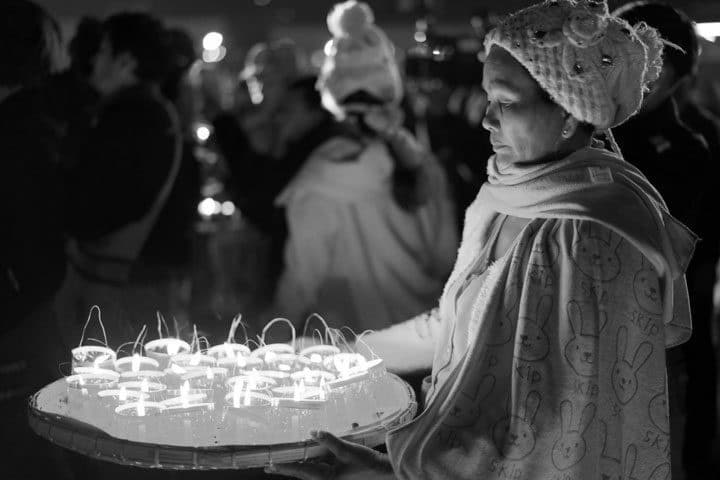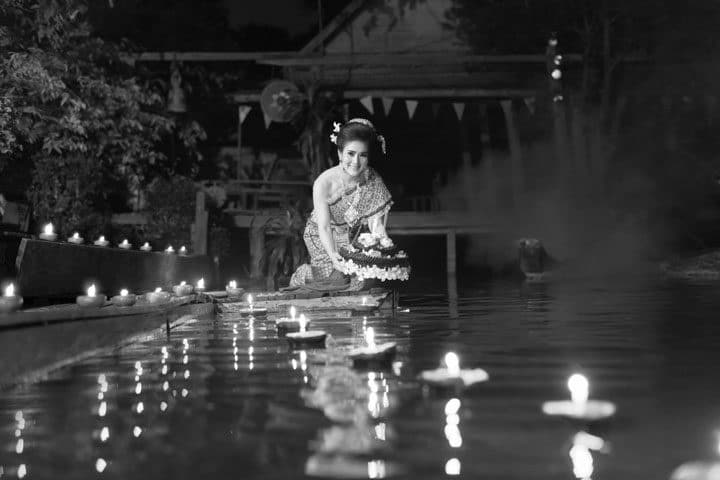The legend of Loy Krathong vetted
In just over a week it will be that time again and the krathongs, the artfully crafted rafts made of banana leaves, float everywhere on the rivers, canals and water features. After Songkran – the traditional Thai New Year – Loy Krathong is the most popular celebration in Thailand and a large part of Southeast Asia.
For example, this autumn festival is known in Laos as Boun That Luang, in Cambodia as Bon Om Touk, in Burma as Tazaungdaing. In the north, around Chiang Mai, Loy Krathong coincides with the Yee Peng festival where thousands of light lanterns, the khom loi, be sent into the air. In our hometown of Satuek - north of Buriram - the traditional and often spectacular boat races on the Mun on the first weekend of November almost always transition seamlessly into Loy Krathong.
Like many other Thai festivals, Loy Krathong has a legend associated with it. According to this tradition, Nang Nopphamat or Noppamas, the beautiful, intelligent and above all devout daughter of a Brahmin, who was attached to the court of the powerful Sukhothai prince Si Inthratit, is said to have launched the first krathong. Si Inthratit, who is considered the founder of the Phra Ruang dynasty, the first Siamese royal family, ruled Sukhothai from about 1238 to 1270.

Tazaungdaing in Burma
This places the beginning of the krathong tradition in the last half of the thirteenth century. She would have done this to thank and propitiate Mae Kong Ka, the goddess of water and one of the five goddesses who in Thai folk beliefs symbolize the five elements, earth, wind, fire, food and water. According to legend, the raft not only carries with it all the sins of the past year, sometimes symbolized by a clipped nail and lock of hair, but also the length of time the flower arrangement floats determines the degree of happiness you have. can acquire in the following year…
According to legend, Nang Nopphamat wanted to thank Mae Kong Ka for the abundant rainfall she brought, which not only provided sufficient drinking water, but also allowed the crops to grow, thus avoiding famine. She made an artful lotus-shaped krathong of banana leaves and, after first showing it to Si Inthartit, launched it with a burning candle and incense sticks. The monarch is said to have been impressed by this initiative and made it an annual court ceremony on the day of the full moon of the twelfth lunar month.
A beautiful legend, but the problem is that not one contemporary chronicle mentions the physical existence of one Nang Nopphamat. She was most likely a fictional character who first appeared in a nineteenth-century publication. The first mention of Nang Nopphamat can be traced to a main figure in a book that is said to have been written in Bangkok during the reign of Rama III, around 1850. She was a literary character presented in this book as a role model and guide for all Siamese women who wanted to engage in public service at the time. She was first associated with Loy Krathong in 1863, when Rama IV explained in a book how this originally Hindu festival (Mae Kong Ka means Ganges) had been adopted by the Buddhists. By encouraging an old folkloric custom, Rama IV probably wanted to make it clear to the western colonial powers that Siam, like the west, had an equally rich cultural heritage…



Dear lung Jan,
That is completely correct that the Loy Krathong has its origin in the sacred Hindu river Ganges (Mae Kong Ka).
Hindus call this river Ma Ganga (Mother Ganges).
Its origins go back thousands of years.
The origin of Ma Ganga:
To understand this properly, I will explain it in detail here.
In this game the three Hindu gods were involved.
Brahma, the creator of life on earth.
Vishnu, the keeper of this creation on earth.
Shiva, the creator and destroyer of the universe. So including the earth.
Brahma created life, including humans.
The first creation of Brahma were the angels (the many Hindu gods and goddesses.
Long story short, some of the descendants of these gods and goddesses were evil, while most of the women were benign and very faithful.
The gods (angels) had several wives.
One of these descendant gods son married a benign and an evil woman (witch).
All the descendants of the benign woman were highly respected by God Vishnu, while the descendants of the witch were totally ignored by Vishnu.
These descendants are known as the devils, of which we have already heard.
These devils became increasingly angry with Vishnu because Vishnu clearly sided with the highly respected angels.
The devils began to seek refuge with the supreme god Shiva.
The premise of Shiva was, the one who worships him by making impossible sacrifices and highly submissive and respects him, that he rewards this worshiper handsomely with divine powers.
All wishes (no matter how evil and dangerous) of this suitor can be fulfilled.
Thus the devils became supreme and the gods (angels) were often defeated in various wars.
And each time the angels had to turn to Brahma, Vishnu and Shiva.
Because some devils got so much power through their sacrifices that even Brahma and Vishnu were threatened.
The rishis of that time belonged to the sons of Brahma.
One day the livestock of one of the devils was stolen. Then a mighty and innocent rishi was accused of theft by the devils.
This was a great insult to the rishi.
A whole group (thousands of) mighty devils went to seek redress from the rishi.
This rishi could not stand the humiliation and became quite angry.
Out of his envy, he began to spit fire from his third eye. And in a matter of minutes, all the demonic soldiers were burned alive and turned into ashes on the spot.
What these devilish soldiers did was one of the worst sins. You were never allowed to insult a rishi, let alone humiliate him.
And this begins the story of the Ganges (Ma Ganga).
When the other devils became powerless because of this heavy loss, they went to seek help from Shiva.
And Shiva could not help them anymore because of the sins they had committed.
Shiva referred them to Brahma. Perhaps Brahma could help them.
Brahma himself could not do anything for them, but he did have a solution for the devils.
Brahma told the devils that he does have someone who can erase all sins and forgive the sins.
Brahma said her name is Ganges.
But how do you get Ganges on earth???
That became a dilemma, because Ganges cannot just descend to earth. Its destructive power would shatter the earth.
So a solution was sought.
And the solution had only God Shiva.
He arranged with Brahma to let Ma Ganga descend on Shiva's head.
With his head and long hair, Shiva would break off the falling force of Ma Ganga and guide the terrible body of water down his long hair to earth.
This is also the origin of the holy river Ganges (Ma Ganga).
Once the great body of water began to flow, the charred remains of diabolical soldiers were also reached. At that time, all these soldiers were brought back to life.
With this, their sins were also erased and also forgiven.
This is the true origin of Loy Krathong.
Sorry for this too long explanation.
This story is in Shiva Purana and Vishnu Purana.
Thank you, a wonderful story.
This week we will also push a raft in our river from the side.
For happiness and as a thank you for happiness enjoyed.
T&Wil